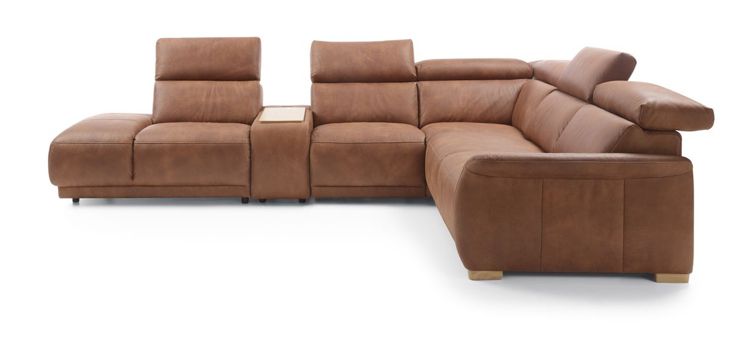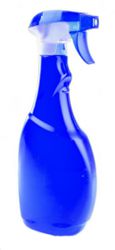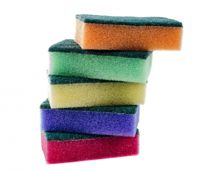10 February 2021
A leather sofa is a beautiful and elegant living room furniture. It is where you relax with your loved ones in the comfort of your home, read your favourite press, take an afternoon nap or watch your favourite TV series. We could say that daily life in your home revolves around the sofa as the centre. But sometimes its appearance can be affected by various surprises. Red wine accidentally spilled with an elbow, somebody sitting in new, strongly dyed jeans, a mischievous baby writing something on the sofa with a crayon, a piece of cake falling on the seat…

What to do then? You have two solutions. The first is to use natural leather care products recommended by Gala Collezione to easily and quickly remove soiling or dirt from the surface, leaving it clean and secured.
The second one is spontaneous experiments with various available agents commonly used at home. The effect? You can be sure that it will be spectacular, but not necessarily in a positive sense. If you want to quickly and effectively damage the leather upholstery on your piece of furniture – here are some ways you can do it.
Aggressive cleaners
 They are perfect for removing rust, limescale and other soiling in the bathroom and kitchen. They are irreplaceable when other agents fail. But while they leave faucets, taps, tiles and other fittings beautiful and shiny, their impacts on natural leather is more drastic. There is a very wide range of possible effects. Discolouration, staining or “corroded holes” are just some of them.
They are perfect for removing rust, limescale and other soiling in the bathroom and kitchen. They are irreplaceable when other agents fail. But while they leave faucets, taps, tiles and other fittings beautiful and shiny, their impacts on natural leather is more drastic. There is a very wide range of possible effects. Discolouration, staining or “corroded holes” are just some of them.
So if you want to damage the furniture upholstery in a quick and spectacular way, clean it with bleach, rust removers, descalers, agents containing abrasive substances or disinfectants. Guaranteed effect. The best way is to pour the liquid directly on the leather in a very visible place. You can be sure that they will perfectly destroy any type of leather. This is confirmed by the fact that the manufacturers of such chemicals recommend using them in gloves.
Spirit, gasoline, turpentine, acetone and other solvents
On our list, they are tied for first place with chemical cleaners. They do not have any protective and care properties, but can wreak real havoc on a leather surface. They will remove the stain for sure, but most likely together with the top layer of the upholstery. They can permanently discolour the leather, leave awful stains or spectacular holes. In addition, they will leave a very strong and unpleasant smell. Such damage is certainly not repairable, all you can do is to replace the cover.
Various fats and waxes
Many websites offer recommend greasing of furniture leather. The authors of these tips often put all types of leather into one bag: both furniture leather and leather used for the production of shoes, bags or saddles, for example. Greasing can be good for saddles and footwear, but it can cause quite a lot of damage in the case of furniture. What kind of damage?
- Changed leather colour – this is because most greases exposed to light turn yellow over time. This applies especially to fats of animal and vegetable origin.
- Leather moulding – most fats increase the formation of mould spores, which is additionally supported by a high humidity in the room where the furniture is placed.
- Leather discolouration by clothing – fats are conductive to the migration of dyes from clothing to leather, which may cause permanent discolouration, particularly when you often sit on the sofa in dark jeans, for example.
- Rotting leather – in the finishing process, furniture leather is often covered with impregnating varnish to protect the surface and at the same time ensure air and water vapour permeability. Fats and waxes leave a layer that reduces the permeability of air and water vapour on leather surfaces. This causes an increase in moisture; the leather loses the ability to dry after contact with the user, feels colder, and in extreme cases it may simply start to rot.
So if you are interested in yellowing, discolouration, stained seat and mould – grease the leather frequently and intensively. To further reinforce the effect, place the sofa in a room where the air humidity exceeds 70%. To get even stronger results, you can also use your own cosmetics, such as oiling creams or petroleum jelly. Such a set ensures the destructive effects of your actions.
Kitchen scourers, wire sponges, paper towels
 Do you want to quickly deteriorate the look of the leather on your sofa? Use wire sponges and scourers instead of soft microfibre cloths. You can be sure they will effectively scratch the surface, removing not only the protective varnish, but also leaving permanent and visible marks. Instead of gently applying the cloth to the surface and waiting for the liquid to soak in, rub it with long and hard with a wire sponge or a paper towel, which will leave small pieces of paper over the entire surface. They will be noticeable especially on waxed, blunt leathers.
Do you want to quickly deteriorate the look of the leather on your sofa? Use wire sponges and scourers instead of soft microfibre cloths. You can be sure they will effectively scratch the surface, removing not only the protective varnish, but also leaving permanent and visible marks. Instead of gently applying the cloth to the surface and waiting for the liquid to soak in, rub it with long and hard with a wire sponge or a paper towel, which will leave small pieces of paper over the entire surface. They will be noticeable especially on waxed, blunt leathers.
Do not dust and clean your leather at all
The sofa is one of the most frequently used pieces of furniture in the living room. It is not surprising that various impurities accumulate on it, including dust, flaked skin and hair, your pet’s hair (if you have a cat or dog, for example), food crumbs, etc. This type of dirt likes to settle in the seams and gaps between the seats. If you give up the regular weekly dusting of your sofa with a soft brush, some eye-catching dust will quickly appear and turn into visible stains after some time. If you additionally grease the leather without cleaning the dirt first, you will definitely preserve the stains, making them immortal.
Overdrying and high temperature
Dishwashing agents, washing liquids and powders, bath liquids – they all contain detergents that strongly dry the leather. Recall how many times you have had chapped hands if you didn’t clean the house with gloves on. Sometimes the skin even started to crack, right? If you want the leather on your sofa to crack as well, clean it with the said agents.
The optimal humidity in the room with a natural leather sofa should not be lower than 40% and higher than 60%. The room should also be ventilated. What can also accelerate leather dryness? Placing the sofa right next to strongly heating radiators and other heat sources or in a place where it will be directly exposed to strong sunlight and drying with hot air. Dry leather will shrink, lose its flexibility and elasticity, and finally crack.
Using agents other than those recommended by the manufacturer
You can currently buy leather furniture finished in several or a dozen or so different ways. Some manufacturers (such as Gala Collezione) prepare dedicated agents for cleaning the leather they offer. They are thoroughly tested and properly selected for the type of leather so as not to change its properties and to maintain it in the right manner.
Using agents other than the recommended ones may turn out to be a lottery. These preparations are apparently dedicated to furniture leather, but we do not entirely know for which type. They often contain fats, waxes or other substances that are not good for cleaning furniture leather.
You already know how to quickly destroy your sofa. But are you sure you want to do it? ;)
« Back to articles list